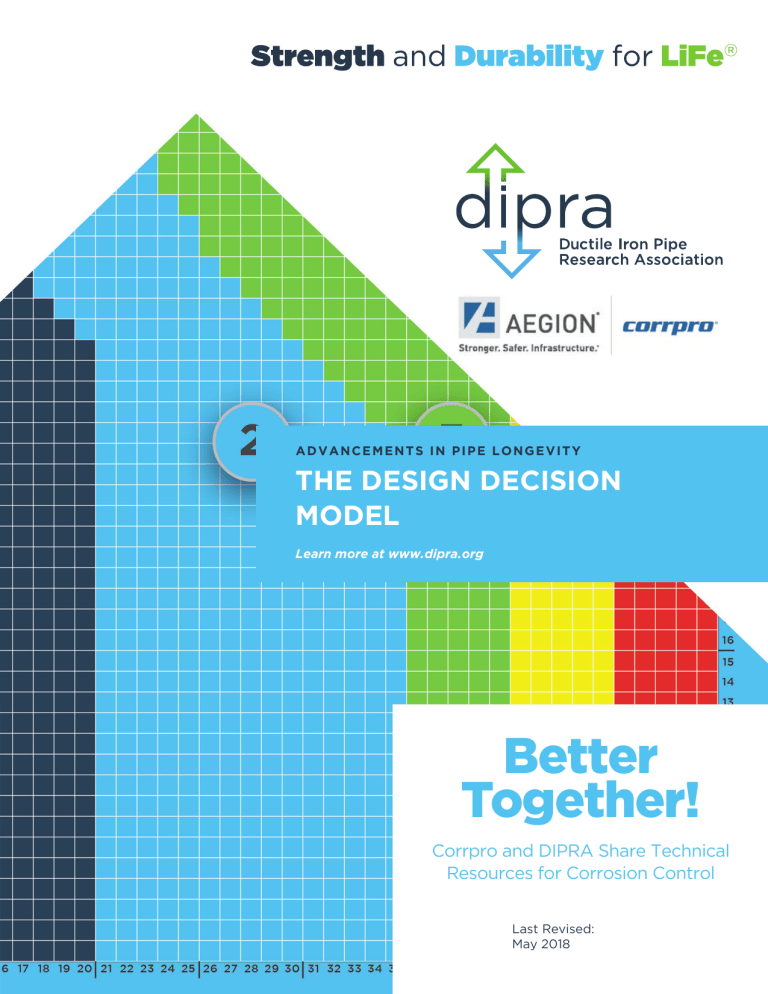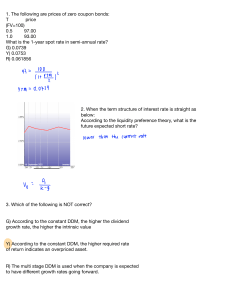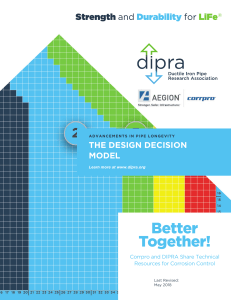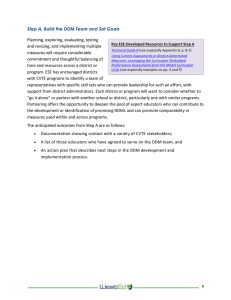
ADVANCEMENTS IN PIPE LONGEVITY THE DESIGN DECISION MODEL Learn more at www.dipra.org Better Together! Corrpro and DIPRA Share Technical Resources for Corrosion Control Last Revised: May 2018 In 2003, the Ductile Iron Pipe Research Association (“DIPRA”) and Corrpro Companies (“Corrpro”), a subsidiary of Aegion Corporation, announced the development of a risk-based model for corrosion control of Ductile iron pipelines—the Design Decision Model® (“DDM®”). The DDM® leveraged the combined experiences, resources and data of DIPRA and its member company technical staffs with corrosion control experts from Corrpro. The DDM® provides a two-dimensional, risk-based model for corrosion control that utilities can use to achieve century-long service lives of their water pipelines. DIPRA provided more than 75 years of research data and decades of hands-on experience with water and wastewater utilities and their engineers. Corrpro brought their extensive knowledge in the control of corrosion, not just for pipe, but for all structures in water and wastewater systems. Together, in a synergistic learning experience covering more than three years, DIPRA gained a higher appreciation of the nuances of corrosion control, and Corrpro came to better understand those aspects of Ductile iron pipe that are an advantage in mitigating corrosion. Where gaps in knowledge or data were identified, the development of the DDM® was augmented by ongoing research efforts in the lab, in DIPRA test sites and in field investigations of existing pipelines. Moreover, those efforts did not stop with the introduction of the DDM® in 2003 and they continue today. The DDM® provided the first two-dimensional risk-based model for corrosion control of Ductile iron pipe—one that balances the likelihood of a corrosion-related concern against the consequences of such an occurrence. The DDM® provides the most practical and effective means of ensuring the century-long service life that users have come to expect as the benchmark for iron pipe. It is that benchmark of service that is the foundation of the life-cycle value for the strongest, most resilient pipe material available today for water and wastewater pipelines. Over the past 15 years, research has continued, and field experiences have increased. We have listened and learned from users of Ductile iron pipe and from other experts in the field. These additions to our collective knowledge have culminated in significant advancements to the DDM®. 2 FIGURE 1 DDM® Two-Dimensional Matrix 1 2 3 4 5 6 7 8 9 10 11 12 13 14 15 16 17 18 19 20 21 22 23 24 25 26 27 28 29 30 31 32 33 34 35 36 37 38 39 40 41 42 43 44 45 46 47 48 49 50 50 50 49 49 48 48 47 47 46 46 45 45 44 44 43 43 42 42 41 41 40 1 2 3 4 5 6 7 8 9 10 11 12 13 14 15 16 17 18 19 20 21 22 23 24 25 26 27 28 29 30 31 32 33 34 35 36 37 38 39 40 41 42 43 44 45 46 47 48 49 50 40 39 50 5039 49 38 4938 4837 48 37 47 36 4736 46 35 4635 45 34 4534 44 33 4433 43 32 4332 42 31 4231 41 30 4130 40 29 4029 39 28 3928 38 27 37 26 36 25 3726 3625 3827 3524 35 24 34 23 3423 3322 33 22 32 21 3221 31 20 3019 31 20 30 19 29 18 28 17 27 16 26 15 25 14 24 13 23 12 22 11 21 10 20 9 19 8 18 7 17 6 16 5 15 4 14 3 13 2 12 1 11 1 2 3 4 5 6 7 8 9 10 10 29 18 28 17 27 16 26 15 25 14 24 13 23 12 22 11 21 10 20 9 19 8 18 7 17 6 16 5 15 4 14 3 13 2 12 1 11 11 12 13 14 15 16 17 18 19 20 21 22 23 24 25 26 27 28 29 30 31 32 33 34 35 36 37 38 39 40 41 42 43 44 45 46 47 48 49 50 10 9 9 8 8 7 7 6 6 5 5 4 4 3 3 TABLE 1 2 2 1 Design Decision Model (DDM ) 1 2 3 4 5 6 7 8 9 10 ® 1 ® 11 12 13 14 15 16 17 18 19 20 21 22 23 24 25 26 27 28 29 30 31 32 33 34 35 36 37 38 39 40 41 42 43 44 45 46 47 48 49 50 3 Since the origin of the DDM®, innovations in polyethylene encasement and the availability of metallized zinc coatings provide options that offer active methods of controlling corrosion. This gives us the ability to design practical mitigation protocols that recognize the differences between transmission and distribution pipelines. For the first time, point counts for the DDM® are published. This means users can access stateof-the-art data for corrosion control methods. Published Factors to Mitigate Corrosion Perhaps most importantly, DIPRA and Corrpro agreed the details of the DDM® should be published, allowing all users of Ductile iron pipe to fully understand the state-of-the-art in corrosion control for Ductile iron pipelines and use this well-founded design tool. In the two-dimensional DDM® model, individual test results for the various contributors to the aggressive nature of a soil result in the assignment of points that accumulate, taking the user along the x-axis in Figure 1: DDM® Two-Dimensional Matrix. Similarly, factors addressing the consequences of corrosion are identified and points accumulate moving the user up the y-axis of the grid in Figure 1. These will intersect in a zone that provides the appropriate design recommendation for mitigation, as shown in Table 1: Recommendations. The listing of the various factors for Likelihood and Consequence, along with their previously unpublished point counts, are found in Tables 2: Likelihood Score Sheet and 3: Consequence Score Sheet. V-Bio® Enhanced Polyethylene Encasement – The Active Inhibitor V-Bio® enhanced polyethylene encasement is now a part of the DDM®. 4 In 2013, based on a decade of research, DIPRA introduced V-Bio® enhanced polyethylene encasement, an innovative polyethylene made possible by co-extrusion technology in film production. This durable material is infused with a volatile corrosion inhibitor and an anti-microbial component that actively prevent the growth of galvanic corrosion cells and depolarizing bacteria in that minimal annular environment between the film and the pipe surface. As a result, V-Bio® enhanced polyethylene encasement is now a part of the DDM®. TABLE 2 Likelihood Score Sheet LIKELIHOOD FACTOR RELATIVE IMPORTANCE 1 = Highest 5 = Lowest RESISTIVITY < 500 ohm-cm > – 500 - 1000 ohm-cm > > > > > 1000 - 1500 ohm-cm 1500 - 2000 ohm-cm 2000 - 3000 ohm-cm 3000 - 5000 ohm-cm 5000 ohm-cm POINTS MAXIMUM POSSIBLE POINTS 30 25 22 19 10 5 0 30 8 3 0 8 5 2.5 0 5 CHLORIDES > 100 ppm = positive 50 - 100 ppm = trace < 50 ppm = negative MOISTURE CONTENT > 15% = Wet 5 - 15% = Moist < 5% = Dry GROUND WATER INFLUENCE Pipe below the water table at any time 5 5 pH pH 0 - 4 pH > 4 - 6 pH 6 - 8, with sulfides and low or negative redox pH > 6 4 1 4 4 0 positive ( > – 1 ppm) trace ( > 0 and < 1 ppm) negative ( 0 ppm) 4 1.5 0 4 REDOX POTENTIAL = negative = positive 0 - 100 mv = positive > 100 mv 2 1 0 2 BI-METALLIC CONSIDERATIONS Connected to noble metals (e.g. copper) - yes Connected to noble metals (e.g. copper) - no 2 2 SULFIDE IONS Known Corrosive Environments 0 TOTAL POSSIBLE POINTS 60 Cinders, Mine Waste, Peat Bog, Landfill, Fly Ash, Coal 21 *S oils with Known Corrosive Environments shall be assigned 21 points or the total of points for Likelihood Factors, whichever is greater. 5 TABLE 3 Consequence Score Sheet RELATIVE CONSEQUENCE FACTOR IMPORTANCE 1 = Highest 5 = Lowest MAXIMUM POSSIBLE POINTS 22 PIPE SERVICE 3” to 24” 30” to 36” 42” to 48” 54” to 64” 0 8 12 22 LOCATION: Construction-Repair Considerations Routine (Fair to good access, minimal traffic/other utility consideration, etc.) 0 Moderate (Typical business/ residential areas, some right of way limitations, etc.) 8 Difficult (Subaqueous crossings, downtown metropolitan business areas, multiple utilities congestion, swamps, etc.) 20 DEPTH OF COVER CONSIDERATIONS 0 to 10 feet depth > 10 to 20 feet depth > 20 feet depth 0 3 5 5 ALTERNATE WATER SUPPLY Alternate supply available - no Alternate supply available - yes 3 0 3 TOTAL POSSIBLE POINTS The revised DDM® recognizes the practical differences in corrosion control needs between transmission mains and distribution systems. 6 POINTS 20 50 DIPRA and Corrpro again listened to the needs of utility operators and recognized the differences between long, large diameter, straight-run transmission mains and the more complicated networks of distribution pipelines that bring water to our neighborhoods and businesses. The result provides a more practical solution for pipeline networks that comprise the distribution systems within a utility’s service area. The use of V-Bio® enhanced polyethylene encasement in conjunction with metallized zinc provides water operators with an effective alternative to controlling corrosion in distribution systems. In recognition of best-practices in the water industry, DIPRA has also adopted and endorsed a method of installing polyethylene encasement that was first observed being used by several utilities. This learning experience resulted from individual utility innovations that DIPRA learned of through the very useful working relationships we strive to develop and maintain with utilities and their engineers. The result is an innovative method that greatly simplifies the installation of V-Bio® enhanced polyethylene, making proper installation much easier to achieve while also addressing concerns expressed by utility operators and corrosion professionals down through the years. Modified Method A, a preferred method for the installation of the V-Bio® film, is described in ANSI/AWWA C105/A21.5. Click here to see a short installation video from our website that will provide the step-by-step procedure. This simple innovation makes installation damage less likely and facilitates the overlap of the encasement across each joint. SUMMARY The DDM® offers a simple, practical means of determining the most economical way to ensure the long service life that utilities and engineers have come to expect from Ductile iron pipelines. The innovations that are now a part of the DDM®—from the use of V-Bio® enhanced polyethylene, to the practical recognition of the different needs for transmission and distribution pipelines, to the innovative new method of installation of the V-Bio® film are only examples of the ongoing efforts our industry is making to better serve the utilities who want and need the great strength and proven resilience of Ductile iron pipe for their water and wastewater systems. Combining the recommendations of the DDM® with an active and determined policy to ensure proper installation will allow those users to experience the unparalleled advantages of Ductile iron throughout its desired life of service. 7 7 For more information contact DIPRA or any of its member companies. Ductile Iron Pipe Research Association Social Media An association of quality producers Get in the flow with Ductile iron pipe dedicated to the highest pipe standards by connecting with us on Facebook, through a program of continuing research Twitter, and LinkedIn. and service to water and wastewater professionals. Visit our website, www.dipra.org and click on the YouTube icon for P.O. Box 190306 informational videos on Ductile iron Birmingham, AL 35219 pipe’s ease of use, economic benefits, 205.402.8700 Tel strength and durability, advantages www.dipra.org over PVC, and more. Member Companies AMERICAN Ductile Iron Pipe P.O. Box 2727 Birmingham, Alabama 35202-2727 www.american-usa.com Canada Pipe Company, Ltd. 55 Frid St. Unit #1 Hamilton, Ontario L8P 4M3 Canada www.canadapipe.com McWane Ductile P.O. Box 6001 Coshocton, Ohio 43812-6001 www.mcwaneductile.com U.S. Pipe Two Chase Corporate Drive Suite 200 Birmingham, Alabama 35244 www.uspipe.com Copyright © 2018 by Ductile Iron Pipe Research Association Strength and Durability for LiFe®



